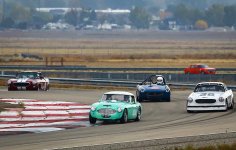There's an ongoing debate about whether or not the spacers, and shims, are even necessary. No American cars of that era had them, to my knowledge, and I don't think any new cars do. The debate--including actual physics--includes whether or not the spacers add strength to the stub axle and some Healey owners have found their cars, purchased used, didn't have them. I'm of the "If the BMC beancounters didn't think they were necessary the cars wouldn't have them" school of thought (my BN2 had/has them, so if BMC found them unnecessary they had a chance to omit them over model changes). Early BJ8 stub axles were known to crack, and Austin did beef them up on later cars, mostly with a larger radius at the base of the spindle (which also has its own spacer). Note also the spindle has a lengthwise notch and the flat washer that goes under the castellated nut has a 'tit' on it so it doesn't rotate. Repop flat washers are poorly cut and I had one spin on me and I thought for sure the bearing had disintegrated (the noise stopped after a few miles when the washer got wedged). The manual gives a torque spec--40-70lb-ft IIRC--but now I torque the holy snot out of them (you aren't going to snap the spindle, though you could destroy the threads I suppose). If you don't use the spacer you can't torque the nut that way; my father, a former auto shop teacher, showed me to tighten the nut to where you can just slide the flat washer around with a screwdriver (won't work with the Healey flat washer, as the I.D. is close to the O.D. of the spindle).
I've installed several sets of bearings, with new races natch--and a couple sets of hubs--on two Healeys and have found "0.030 of spacers give-or-take a thou or three works well. I used to use a micrometer to set end float, something like "0.003 IIRC, but now I just set them so there is just a smidge of end play, and never had an issue over thousands of miles.

 Hi Guest!
Hi Guest!

 smilie in place of the real @
smilie in place of the real @
 Pretty Please - add it to our Events forum(s) and add to the calendar! >>
Pretty Please - add it to our Events forum(s) and add to the calendar! >> 



